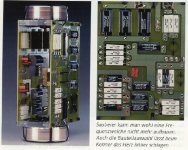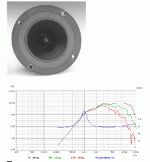I was wondering if there was any difference between crossovers mounted on pcbs and point to point soldering?
and if some solder is prefered next to another one....
and if some solder is prefered next to another one....
Resin Core solder only for electronic work.
If the crossover is simple and the components can be supported easily by the wiring, boartds are not reallly necessary.
If this is the project we discussed-the 4 inch Cambridge mid and the nameless tweeter- what crossover did you decide on and did you make it up yourself or have it designed? If so, where?
If the crossover is simple and the components can be supported easily by the wiring, boartds are not reallly necessary.
If this is the project we discussed-the 4 inch Cambridge mid and the nameless tweeter- what crossover did you decide on and did you make it up yourself or have it designed? If so, where?
If this is your personal project and not commercial offering I would never bother with PCB. Use a piece of MDF and hot glue and assemble all the crossover components in this way. It is also recommended that the coil orientation is 90 deg to ea. other. Use components leads for connection and you are done.
Some say that silicon is better, but it's pain when for some reason you have to change something or use parts for a different crossover. Hot glue is the best.
Some say that silicon is better, but it's pain when for some reason you have to change something or use parts for a different crossover. Hot glue is the best.
And if you can, put it in a separate box outside the speaker, it will sound better, and is easier for tweaking😉
A rule of tumb for avoiding cross talk between the coils is to mount them at 90 degree and when looking through the hole of the coil you should not see the other coil.
Thanks all for the replies
Kelticwizard,
I used the same tweeter, but changed to a unnamed 5" (wich I saw the SAME one on some technics speakers some days ago(the same one as in the post i did about it some days ago))
I went for first order in the XO because, I prefer using it when i can.
one thing I worried about is playing the speaker at high lvls, the tweeter's Fx is 2000 hz, and with first order, one octave down, thats 6db wich still is somehow hard on the tweeter xmax when theres high listening lvls involved. i might try a second order at same Fx, or a first order at higher Fx.
Kelticwizard,
I used the same tweeter, but changed to a unnamed 5" (wich I saw the SAME one on some technics speakers some days ago(the same one as in the post i did about it some days ago))
I went for first order in the XO because, I prefer using it when i can.
one thing I worried about is playing the speaker at high lvls, the tweeter's Fx is 2000 hz, and with first order, one octave down, thats 6db wich still is somehow hard on the tweeter xmax when theres high listening lvls involved. i might try a second order at same Fx, or a first order at higher Fx.
Some years ago, before Ferrofluid, a lot of tweeters were rated by their manufacturers as:
2nd order crossover-2000 Hz
Ist order crossover-4000 Hz
Not such a bad guideline today, Ferrofluid or no.
PS: Try disconnecting the woofer and tweeter from the crossover. Place side-to-side. Hook the woofer up to one channel of an amp, then the tweeter to the other. Use the "Balance" control to play the tone through the woofer, then through the tweeter. Go back and forth several times. Try to judge if there is a loudness difference.
Then repeat with a 3000 Hz tone, then a 4000 Hz tone.
Just want to make sure that the tweeter is not a super efficent horn job.
2nd order crossover-2000 Hz
Ist order crossover-4000 Hz
Not such a bad guideline today, Ferrofluid or no.
PS: Try disconnecting the woofer and tweeter from the crossover. Place side-to-side. Hook the woofer up to one channel of an amp, then the tweeter to the other. Use the "Balance" control to play the tone through the woofer, then through the tweeter. Go back and forth several times. Try to judge if there is a loudness difference.
Then repeat with a 3000 Hz tone, then a 4000 Hz tone.
Just want to make sure that the tweeter is not a super efficent horn job.
Here is a picture of a Peerless 811647 horn loaded soft dome tweeter. Granted, the front faceplate is flush with the opening of the horn, but still. AT 3000 Hz, the response is up around 100 dB!! I am hoping your horn tweeter does not have a response like this, in which case your crossover would have to be completely different.
Attachments
- Status
- Not open for further replies.
- Home
- Loudspeakers
- Multi-Way
- Point to point crossover soldering

